
Plain City is a village in Madison and Union counties in the U.S. state of Ohio, along Big Darby Creek. The population was 4,065 at the 2020 census.
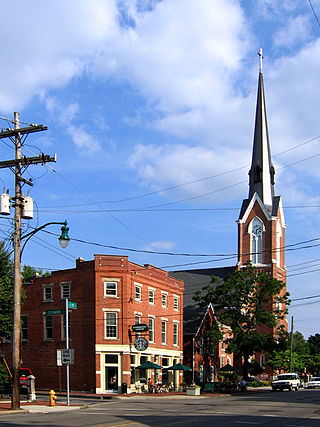
German Village is a historic neighborhood in Columbus, Ohio, just south of the city's downtown. It was settled in the early-to-mid-19th century by a large number of German immigrants, who at one time comprised as much as a third of the city's entire population. It became a city historic district in 1960 and was added to the National Register of Historic Places in 1974, becoming the list's largest privately funded preservation district, and in 2007, was made a Preserve America Community by the federal government. In 1980, its boundaries increased, and today it is one of the world's premier historic restorations.

The Irwin Conference Center was designed by Eero Saarinen and built in 1954 in Columbus, Indiana, United States. It is currently owned and operated by Cummins, whose world headquarters is located across Jackson Street in the Cummins Corporate Office Building. In recognition of its unique and beautiful design, the resource was designated a National Historic Landmark by the National Park Service in 2001.

Franklin National Bank is a bank based in Franklin Square on Long Island, New York. It was once the United States' 20th largest bank. On October 8, 1974, it collapsed in obscure circumstances involving Michele Sindona, who was a renowned Mafia-banker and member of the irregular freemasonic lodge Propaganda Due. It was at the time the largest bank failure in the history of the country.

University, Hayes and Orton Halls are three historic buildings on the Oval at the Ohio State University in Columbus, Ohio. On July 16, 1970, they were added to the National Register of Historic Places. The original University Hall was demolished in 1971, and removed from the National Register that year.

William Creighton Jr. was the 1st Secretary of State of Ohio, a United States representative from Ohio and a United States district judge of the United States District Court for the District of Ohio.

Loews Philadelphia Hotel, previously known as the PSFS Building, is a skyscraper in Center City, Philadelphia, Pennsylvania. A National Historic Landmark, the building was the first International style skyscraper constructed in the United States.

Dollar Bank is a full-service regional savings bank serving both individuals and business customers, operating more than 90 offices throughout Pennsylvania, Ohio, Maryland, and Virginia. The bank's corporate headquarters is located in downtown Pittsburgh alongside its Pennsylvania regional headquarters. The Ohio headquarters is located in downtown Cleveland, and Virginia headquarters is located in Hampton Roads.
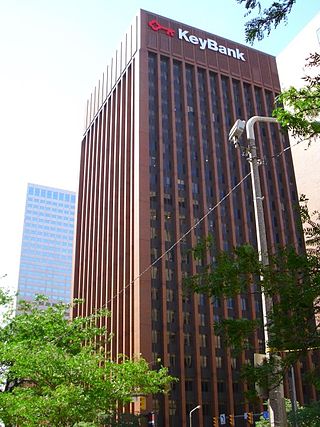
AmTrust Bank was a bank based in Cleveland, Ohio. The company was founded in 1889 and was closed in December 2009.

Huntington Bancshares Incorporated is an American bank holding company headquartered in Columbus, Ohio. The company is ranked 466th on the Fortune 500 as of 2024, and is 26th on the list of largest banks in the United States.
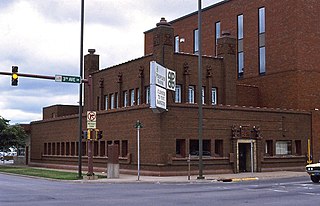
The Peoples Savings Bank in Cedar Rapids, Iowa, was designed by Louis Sullivan. It was the second of a number of small "jewel box" banks in midwest towns designed by Sullivan during 1907 to 1919. It was built in 1911, and it was individually listed on the National Register of Historic Places in 1978. In 2014 it was included as a contributing property in the West Side Third Avenue SW Commercial Historic District.
Sovran Bank was a US-based regional bank that operated in Virginia between 1983 and 1990, and was the leading subsidiary of Sovran Financial Corporation. It was itself a product of a merger between First & Merchants Bank of Richmond and Virginia National Bankshares of Norfolk, both of which could trace back their history to the 1860s. In 1990, it was merged with Citizens & Southern National Bank to form C&S/Sovran Corp., which in turn merged with NCNB to form NationsBank which became Bank of America in 1998.

The 1942 Farmers and Mechanics Savings Bank building in downtown Minneapolis, Minnesota, United States is a former bank building that is now the home of a Westin Hotel. The building is an example of the Streamline Moderne phase of the Art Deco movement and is notable for its bold relief sculptures of a farmer and a mechanic framing the main entrance. The sculptures were designed by Warren T. Mosman, who headed the sculpture department at the Minneapolis Institute of Arts. The structure was listed on the National Register of Historic Places in 2006.

The Farmers and Merchants Union Bank is a historic commercial building at 159 West James Street in Columbus, Wisconsin. Built in 1919, it is the last of eight "jewel box" bank buildings designed by Louis Sullivan, and the next to last to be constructed. It was declared a National Historic Landmark in 1976 for its architecture.

Frank L. Packard was a prominent architect in Ohio. Many of his works were under the firm Yost & Packard, a company co-owned by Joseph W. Yost.
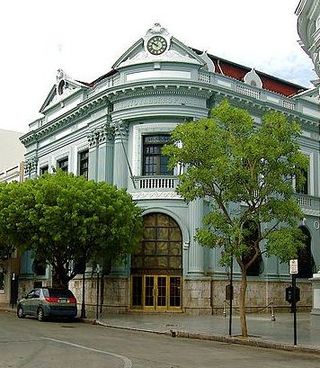
Banco Crédito y Ahorro Ponceño was the first bank in Ponce, Puerto Rico, and one of the first two native Puerto Rican banks to be established in Puerto Rico. The bank was the first one to introduce a bank credit card to the Puerto Rican market. With over 50 branches throughout the island, the bank was one of the largest banking companies in Puerto Rico during most of the twentieth century.

The Citizens Building is a high-rise office and retail building located at 840 Euclid Avenue in Cleveland, Ohio, in the United States. The structure was built in 1903 by the Citizens Savings and Trust, a local bank. Its entrance portico was removed in 1924, and a two-story addition erected in its place. Home to the City Club of Cleveland since 1982, the building was renamed the City Club Building in 1999.

The First National Bank is a historic bank building in Huntsville, Alabama. The temple-form Greek Revival structure was built in 1835–1836. Designed by locally famous architect George Steele, it occupies a prominent position, facing the courthouse square and sitting on a bluff directly above the Big Spring. It was the longest-serving bank building in Alabama, operating until 2010 when Regions Bank moved their downtown branch to a new location. The building was listed on the National Register of Historic Places in 1974.
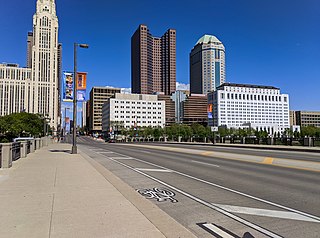
Broad Street is a major thoroughfare in Central Ohio, predominantly in Franklin County and Columbus. It stretches east from West Jefferson at Little Darby Creek to Pataskala. The street is considered one of Columbus's two main roads, along with High Street.
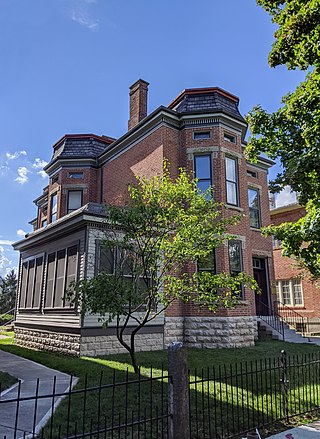
The Columbus Landmarks Foundation, known as Columbus Landmarks, is a nonprofit historic preservation organization in Columbus, Ohio. The foundation is best-known for its list of endangered sites in the city and its annual design award, given to buildings, landscapes, and other sites created or renovated in Columbus. It was established in 1977 as a project of the Junior League of Columbus, Ohio, following the demolition of the city's historic Union Station. It is headquartered at 57 Jefferson Avenue, a contributing structure in the Jefferson Avenue Historic District in Downtown Columbus.
























